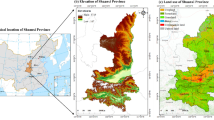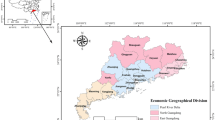Abstract
Through the matching relationship between land use types and carbon emission items, this paper estimated carbon emissions of different land use types in Nanjing City, China and analyzed the influencing factors of carbon emissions by Logarithmic Mean Divisia Index (LMDI) model. The main conclusions are as follows: 1) Total anthropogenic carbon emission of Nanjing increased from 1.22928 × 107 t in 2000 to 3.06939 × 107 t in 2009, in which the carbon emission of Inhabitation, mining & manufacturing land accounted for 93% of the total. 2) The average land use carbon emission intensity of Nanjing in 2009 was 46.63 t/ha, in which carbon emission intensity of Inhabitation, mining & manufacturing land was the highest (200.52 t/ha), which was much higher than that of other land use types. 3) The average carbon source intensity in Nanjing was 16 times of the average carbon sink intensity (2.83 t/ha) in 2009, indicating that Nanjing was confronted with serious carbon deficit and huge carbon cycle pressure. 4) Land use area per unit GDP was an inhibitory factor for the increase of carbon emissions, while the other factors were all contributing factors. 5) Carbon emission effect evaluation should be introduced into land use activities to formulate low-carbon land use strategies in regional development.
Similar content being viewed by others
References
Ali G, Nitivattananon V, 2012. Exercising multidisciplinary approach to assess interrelationship between energy use, carbon emission and land use change in a metropolitan city of Pakistan. Renewable and Sustainable Energy Reviews, 16(1): 775–786. doi: 10.1016/j.bbr.2011.03.031
Ang B W, 2004. Decomposition analysis for policymaking in energy: Which is the preferred methods? Energy Policy, 32(9): 1131–1139. doi: 10.1016/S0301-4215(03)00076-4
Araujo M S M, Silva C, Campos C P, 2009. Land use change sector contribution to the carbon historical emissions and the sustainability—Case study of the Brazilian Legal Amazon. Renewable and Sustainable Energy Reviews, 13(3): 696–702. doi: 10.1016/j.rser.2007.10.008
Cai Bofeng, Liu Chunlan, Chen Caocao, 2009. City’s Greenhouse Gas Emission Inventory Research. Beijing: Chemical Industry Press. (in Chinese)
Christen A, Coops N, Kellett R et al., 2010. A LiDAR-based Urban Metabolism Approach to Neighborhood Scale Energy and Carbon Emissions Modeling. University of British Columbia.
Churkina G, 2008. Modeling the carbon cycle of urban systems. Ecological Modeling, 216(2): 107–113. doi: 10.1016/j.ecolmodel.2008.03.006
DeFries R S, Field C B, Fung I et al., 1999. Combining satellite data and biogeochemical models to estimate global effects of human-induced land cover change on carbon emissions and primary productivity. Global Biogeochemical Cycle, 13(3): 803–815. doi: 10.1029/1999GB900037
Duan Xiaonan, Wang Xiaoke, Lu Fei et al., 2008. Carbon sequestration and its potential by wetland ecosystems in China. Acta Ecologica Sinica, 28(2): 463–469. (in Chinese)
Fang J Y, Chen A P, Peng C H et al., 2001. Changes in forest biomass carbon storage in China between 1949 and 1998. Science, 292(5525): 2320–2322. doi: 10.1126/science.1058629
Fang Jingyun, Guo Zhaodi, Piao Shilong et al., 2007. Estimation on terrestrial vegetation carbon sinks in China from 1981 to 2000. Science in China (Series D), 37(6): 804–812. (in Chinese)
Fang Jingyun, Liu Guohua, Xu Songling, 1996. Carbon cycle of terrestrial ecosystem in China and its global meaning. In: Wang Gengchen et al. (eds). The Measurement of Greenhouse Gases and Their Release and Related Processes. Beijing: China Environment Science Press, 129–139. (in Chinese)
Ge Quansheng, Dai Junhu, He Fanneng et al., 2008. Research on land use/land cover change and carbon cycle in the past 300 years in China. Science in China (Series D), 38(2): 197–210. (in Chinese)
Guan Dongsheng, Chen Yujuan, Huang Fenfang, 1998. The storage and distribution of carbon in urban vegetation and its roles in balance and oxygen in Guangzhou. China Environmental Science,18(5): 437–441. (in Chinese)
Guo Yungong, 2009. The Analysis on Calculation and Characteristics of Greenhouse Gas Emission in Mega-cities. Shanghai: East China Normal University. (in Chinese)
Houghton R A, 1999. The annual net flux of carbon to the atmosphere from changes in land use 1850–1990. Tellus Series B-Chemical and Physical Meteorology, 51(2): 298–313. doi: 10.1034/j.1600-0889.1999.00013.x
Houghton R A, Hackler J L, 2003. Sources and sinks of carbon from land-use change in China. Global Biogeochemical Cycles, 17(2): 1034–1047. doi: 10.1029/2002GB001970
Houghton R A, Hackler J L, Lawrence K T, 1999. The U.S. Carbon Budget: Contributions from land-use change. Science, 285(5427): 574–578. doi: 10.1126/science.285.5427.574
IPCC (Intergovernmental Panel on Climate Change), 2006. 2006 IPCC Guidelines for National Greenhouse Gas Inventories.
Kalnay E, Cai M, 2003. Impact of urbanization and land-use change on climate. Nature, 423: 528–531.
Koemer B, Klopatek J, 2002. Anthropogenic and natural CO2 emission sources in an arid urban environment. Environmental Pollution, 116(S1): S45–S51. doi: 10.1016/S0269-7491(01)00246-9
Kuang Yaoqiu, Ouyang Tingping, Zou Yi et al., 2010. Present situation of carbon source and sink and potential for increase of carbon sink in Guangdong Province. China Population Resources and Environment, 20(S): 154–158. (in Chinese)
Kwon H Y, Mueller S, Dunn J B et al., 2013. Modeling state-level soil carbon emission factors under various scenarios for direct land use change associated with United States biofuel feedstock production. Biomass and Bioenergy, 55: 299–310. doi: 10.1016/j.biombioe.2013.02.021
Lai Li, Huang Xianjin, 2011. Carbon Emission Effect of Land Use in China. Nanjing: Nanjing University Press. (in Chinese)
Li Kerang, 2000. Land Use Change, Net Emission of Greenhouse Gases and the Carbon Cycle in Terrestrial Ecosystems. Beijing: China Meteorological Press, 260. (in Chinese)
Liu Hongguang, Liu Weidong, 2009. Decomposition of energy-induced CO2 emissions in industry of China. Progress in Geography, 28(2): 285–292. (in Chinese)
Liu L C, Fan Y, Wu G et al., 2007. Using LMDI method to analyze the change of China’s industrial CO2 emissions from final fuel use: An empirical analysis. Energy Policy, 35(11): 5892–5900. doi: 10.1016/j.enpol.2007.07.010
Ma C B, Stern D I, 2008. Biomass and China’s carbon emissions: A missing piece of carbon decomposition. Energy Policy, 36(7): 2517–2526. doi: 10.1016/j.enpol.2008.03.013
Malla S, 2009. CO2 emissions from electricity generation in seven Asia-Pacific and North American countries: A decomposition analysis. Energy Policy, 37(1): 1–9. doi: 10.1016/j.enpol.2008.08.010
McGuire A D, Sitch S, Clein J S et al., 2001. Carbon balance of the terrestrial biosphere in the twentieth century: Analyses of CO2, climate and land use effects with four process-based ecosystem models. Global Biogeochemical Cycle, 15(1): 183–206. doi: 10.1029/2000GB001298
Ministry of Housing and Urban-rural Development of China, 2010. China Urban Construction Statistical Yearbook. Beijing: China Planning Press. (in Chinese)
Nanjing Statistical Bureau, 2010a. Statistical Yearbook of Nanjing City. Nanjing: Nanjing Press. (in Chinese)
Nanjing Statistical Bureau, 2010b. General Economic Surveying Yearbook of Nanjing. Nanjing: Nanjing Press. (in Chinese)
National Bureau of Statistics of China, 2008. China Energy Statistical Yearbook. Beijing: China Statistics Press. (in Chinese)
Quay P D, Tilbrook B, Wong C S, 1992. Oceanic uptake of fossil fuel CO2: Carbon-13 evidence. Science, 256(5053): 74–79. doi: 10.1126/science.256.5053.74
Schindler D W, 1999. Carbon cycling: The mysterious missing sink. Nature, 398: 105–107. doi: 10.1038/18111
Shao C F, Guan Y, Wan Z et al., 2014. Performance and decomposition analyses of carbon emissions from industrial energy consumption in Tianjin, China. Journal of Cleaner Production, 64: 590–601. doi: 10.1016/j.jclepro.2013.08.017
Soytasa U, Sari R, Ewing B T, 2007. Energy consumption, income, and carbon emissions in the United States. Ecological Economics, 62(3–4): 482–489. doi: 10.1016/j.ecolecon.2006.07.009
Statistical Bureau of Jiangsu Province, 2010. Statistical Yearbook of Jiangsu Province. Beijing: China Statistics Press. (in Chinese)
Svirejeva-Hopkins A, Schellnhuber H J, 2006. Modelling carbon dynamics from urban land conversion: fundamental model of city in relation to a local carbon cycle. Carbon Balance and Management, 1: 1–8. doi: 10.1186/1750-0680-1-8
Svirejeva-Hopkins A, Schellnhuber H J, 2008. Urban expansion and its contribution to the regional carbon emissions: Using the model based on the population density distribution. Ecological Modelling, 216(2): 208–216. doi: 10.1016/j.ecolmodel.2008.03.023
Tang Hongxia, Han Dan, Zhao Youcai, 2009. Greenhouse Gases Emission Reduction and Controlling Technology of Agriculture and Forestry. Beijing: Chemical Industry Press, 87–99. (in Chinese)
Tian X, Chang M, Shi F et al., 2012. Structural decomposition analysis of the carbonization process in Beijing: A regional explanation of rapid increasing carbon dioxide emission in China. Energy Policy, 53: 279–286. doi: 10.1016/j.enpol.2012.10.054
Tunc G I, Turut-Asik S, Akbostanci E, 2009. A decomposition analysis of CO2 emissions from energy use: Turkish case. Energy Policy, 37(11): 4689–4699. doi: 10.1016/j.enpol.2009.06.019
Xie Hongyu, Chen Xiansheng, Lin Kairong, 2008 The ecological footprint analysis of fossil energy and electricity. Acta Ecologica Sinica, 28(4):1729–1735. (in Chinese)
Xu Guoquan, Liu Zeyuan, Jiang Zhaohua, 2006. Decomposition model and empirical study of carbon emissions for China, 1995–2004. China Population Resources and Environment, 16(6): 158–161. (in Chinese)
Ye Duzheng, Chen Panqin, 1992. Study on Prediction of Global Change in China (the second part). Beijing: Earthquake Press. (in Chinese)
Zhang C, Tian H Q, Chen G S et al., 2012. Impacts of urbanization on carbon balance in terrestrial ecosystems of the Southern United States. Environmental Pollution, 164: 89–101. doi: 10.1016/j.envpol.2012.01.020
Zhao M, Tan L R, Zhang W G et al., 2010. Decomposing the influencing factors of industrial carbon emissions in Shanghai using the LMDI method. Energy? 35(6): 2505–2510. doi: 10.1016/j.energy.2010.02.049
Zhao R Q, Huang X J, Zhong T Y et al., 2011. Carbon footprint of different industrial spaces based on energy consumption in China. Journal of Geographical Sciences, 21(2): 285–300. doi: 10.1007/s11442-011-0845-6
Author information
Authors and Affiliations
Corresponding author
Additional information
Foundation item: Under the auspices of National Natural Science Foundation of China (No. 41301633), National Social Science Foundation of China (No. 10ZD&030), Postdoctoral Science Foundation of China (No. 2012M511243, 2013T60518), Clean Development Mechanism Foundation of China (No. 1214073, 2012065)
Rights and permissions
About this article
Cite this article
Zhao, R., Huang, X., Liu, Y. et al. Carbon emission of regional land use and its decomposition analysis: Case study of Nanjing City, China. Chin. Geogr. Sci. 25, 198–212 (2015). https://doi.org/10.1007/s11769-014-0714-1
Received:
Accepted:
Published:
Issue Date:
DOI: https://doi.org/10.1007/s11769-014-0714-1




